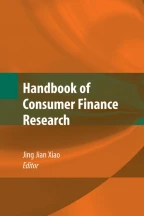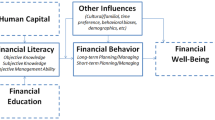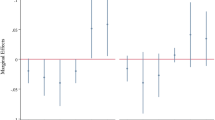Financial Literacy of High School Students

Five, large-scale, biennial national surveys of high school seniors from 1997 to 2006 have been used to measure the financial literacy of young American adults. The results show a low level of ability to make age-appropriate financial decisions in their own self-interests. Low baseline results in 1997 have further deteriorated with scores on the 31-question, multiple choice exam now hovering just over 50 %. Students from families with greater financial resources tend to be substantially more financially literate than those from families that are less well-off, thereby exacerbating the inequality of economic welfare among families. Moreover, high school classes in personal finance and money management have not proven to be effective in raising levels of financial literacy.
This is a preview of subscription content, log in via an institution to check access.
Access this chapter
Subscribe and save
Springer+ Basic
€32.70 /Month
- Get 10 units per month
- Download Article/Chapter or eBook
- 1 Unit = 1 Article or 1 Chapter
- Cancel anytime
Buy Now
Price includes VAT (France)
eBook EUR 80.24 Price includes VAT (France)
Softcover Book EUR 100.21 Price includes VAT (France)
Tax calculation will be finalised at checkout
Purchases are for personal use only
Preview
Similar content being viewed by others

Financial Literacy of High School Graduates: Long- and Short-Term Financial Behavior by Age Group
Article 03 May 2019

Financial Literacy and Financial Education in High School
Chapter © 2016

Early Causes of Financial Disquiet and the Gender Gap in Financial Literacy: Evidence from College Students in the Southeastern United States
Article 26 February 2020
References
- Alexander, R. J. (1979). State consumer education policy manual. Denver, CO: Education Commission of the States. Google Scholar
- Alhabeeb, M. J. (1999). Teens’ consumption patterns: The impact of employment status and intensity. Academy of Marketing Studies Journal, 2(1), 45–54. Google Scholar
- Bannister, R., & Monsma, C. (1982). Classification of concepts in consumer education. Cincinnati, OH: South-Western Publishing. Google Scholar
- Bernheim, B. D., Garrett, D. M., & Maki, D. M. (2001). Education and saving: The long-term effects of high school financial curriculum mandates. Journal of Public Economics, 80(3), 435–465. ArticleGoogle Scholar
- Braunstein, S., & Welch, C. (2002). Financial literacy: An overview of practice, research and policy. Federal Reserve Bulletin, 87(11) (November), 445–457. Google Scholar
- Chen, H., & Volpe, R. P. (1998). An analysis of personal financial literacy among college students. Financial Services Review, 7, 107–128. ArticleGoogle Scholar
- Currie, J., & Thomas, D. (1995). Does head start make a difference? American Economic Review, 85(3), 341–364. Google Scholar
- Danes, S. M. (2004). Evaluation of the nefe high school financial planning program ® 2003–2004. St. Paul, MN: University of Minnesota, Family Social Science Department. Google Scholar
- Danes, S. M., Huddleston-Casas, C., & Boyce, L. (1999). Financial planning curriculum for teens: impact evaluation. Financial Counseling and Planning, 10(1), 25–37. Google Scholar
- Greenspan, A. (2003). The importance of financial and economic literacy. Social Education, 67(2), 70–72. Google Scholar
- Greenspan, A. (2005). The importance of financial education. Social Education, 69(2), 64–66. Google Scholar
- Hilgert, M., Hogarth, J., & Beverly, S. (2003). Household financial management: The connection between knowledge and behavior. Federal Reserve Bulletin, July, 309–322. Google Scholar
- Joo, S., & Grable, J. E. (2000). Improving employee productivity: The role of financial counseling and education. Journal of Employment Counseling, 37, 2–15. Google Scholar
- Jump$tart Coalition for Personal Financial Literacy. (2007). National standards in k-12 personal finance education with benchmarks, knowledge statements, and glossary, Washington, DC: Author. Google Scholar
- Lucey, T. A. (2005). Assessing the reliability and validity of the jump$tart survey of financial literacy. Journal of Family and Economic Issues, 26(2), 283–294. ArticleGoogle Scholar
- Mandell, L. (1998). Our vulnerable youth: The financial literacy of American 12 th graders. Washington, DC: Jumpstart Coalition. Google Scholar
- Mandell, L. (2001). Improving financial literacy: What schools and parents can and cannot do. Washington, DC: Jumpstart Coalition. Google Scholar
- Mandell, L. (2003). Financial literacy, a growing problem: Results of the 2002 national Jump$tart survey. Washington, DC: Jumpstart Coalition. Google Scholar
- Mandell, L. (2004). Financial literacy: Are we improving? Results of the 2004 national Jump$tart survey. Washington, DC: Jumpstart Coalition. Google Scholar
- Mandell, L. (2005, April). Financial literacy: Does it matter? (Working paper). Buffalo, NY: SUNY at Buffalo. Google Scholar
- Mandell, L. (2006a). Financial literacy: Improving education; Results of the 2006 national Jump$tart survey. Washington, DC: Jumpstart Coalition. Google Scholar
- Mandell, L. (2006b, January). The impact of financial literacy education on subsequent financial behavior (Working Paper). Buffalo, NY: SUNY at Buffalo. Google Scholar
- Mandell, L. (2006c, January). Does just in time instruction improve financial literacy? Credit Union Magazine, Savingteen Supplement, 7–9. Google Scholar
- Mandell, L. (2007a). Financial education in high school. In A. Lusardi (Ed.), Improving the effectiveness of financial education and savings programs: Conference handbooks (pp. 11–33). Cambridge, MA: NBER and Dartmouth College. Google Scholar
- Mandell, L. (2007b, January). Teaching new dogs old tricks. Savingteen, 4–5. Google Scholar
- Mandell, L., & Klein, L. S. (2007). Motivation and financial literacy. Financial Services Review, 16(2), 106–116. Google Scholar
- Marshall, H. R., & Magruder, L. (1960). Relations between parent, money, education practices and children’s use of money. Child Development, 31, 253–284. PubMedGoogle Scholar
- Murray, D. (2002). How much do your kids know about credit? Medical Economics, 77(16), 58–66. Google Scholar
- National Association of State Boards of Education. (2006). Who owns our children? Alexandria, VA: Author. Google Scholar
- Organization for Economic Co-operation and Development. (2005). Improving financial literacy: Analysis of issues and policies. Paris: Author. Google Scholar
- Scott, C. H. (1990). 1990 National survey: The status of consumer education in the United States schools, grades k-12. Madison, NJ: National Coalition for Consumer Education. Google Scholar
- Tennyson, S., & Nguyen, C. (2001). State curriculum mandates and student knowledge of personal finance. The Journal of Consumer Affairs, 35(2), 241–262. ArticleGoogle Scholar
- Volpe, R. P., Chen, H., & Lui, S. (2006). An analysis of the importance of personal finance topics and the level of knowledge possessed by working adults. Financial Services Review, 15(1), 81–99. Google Scholar
Author information
Authors and Affiliations
- Department of Finance, State University of New York at Buffalo, University at Buffalo, 375 Jacobs Hall, Buffalo, NY 14260–4000, USA Lewis Mandell
- Lewis Mandell



